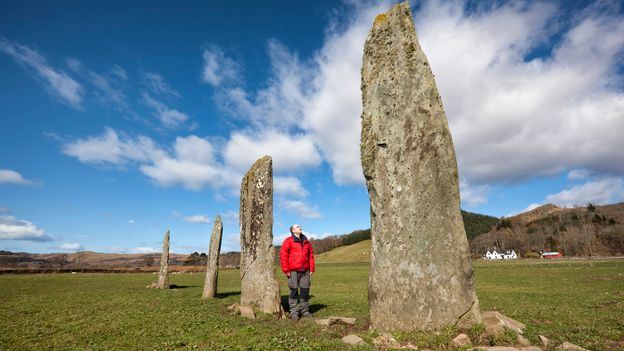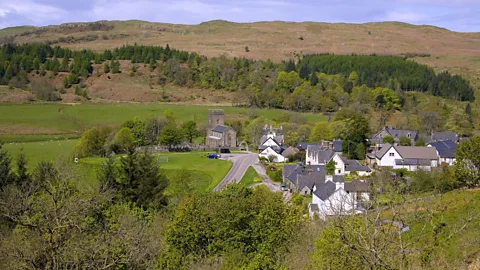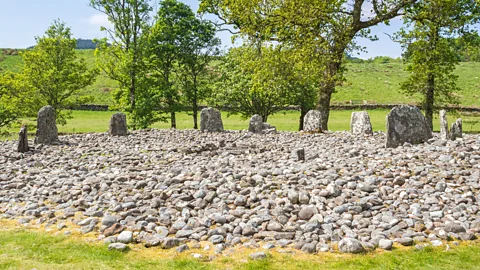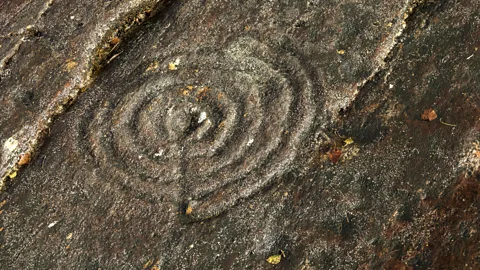Travel
Scotland’s enormous, unknown treasure trove

 Getty Images
Getty ImagesForgotten for centuries, Kilmartin Glen in Argyll is one of Britain’s most important archaeological landscapes – but most people have never heard of it.
On the road north-west from Glasgow through the hills of Argyll, civilisation peels away and the landscape becomes emptier of life and stories – but only to the untrained eye.
As the road clears Loch Fyne, curving north out of the village of Lochgilphead, the great expanse of Kilmartin Glen comes into view. This was once the Scotland seen by the 6th- and 7th-Century kings of the ancient Gaelic kingdom Dál Riata, and the raised bogland greets the visitor with rumpled hills, fields settled by Blackface sheep and forests planted with deeply-rooted oak.
But look closer – much closer still, as the road weaves north to harbour town Oban – and it quickly becomes clear that Kilmartin Glen is a place where history lurks in great abundance. For this is the setting of a prehistoric collection of henge monuments, burial cairns, standing stones, cist chambers, stone circles and the densest concentration of rock art sites anywhere in Britain, with more than 800 ancient relics at the last count.
This multitude was built before the Romans and Greeks came along, before the first pyramids were built some 4,700 years ago and before Stonehenge, Britain’s other great prehistoric monument. Interpretations of Kilmartin Glen by various archaeologists and antiquarians all agree it is one of Britain’s greatest treasures.
Yet the strangest thing is that most people have never heard of it.
 Getty Images
Getty ImagesAnd as I discovered, the glories of the glen are the result of more than 5,000 years of history, but also a decades-long battle between preservation and the forces of nature itself.
I met museum archaeologist Dr Aaron Watson at the entrance to the new Kilmartin Museum, which reopened to the public in late April after a £7.5m revamp. Soon after, we began our journey back in time, all alone, and with an eerie quiet settling over the glen.
“Unlike so many heritage sites on this scale, everywhere is open and waiting to be discovered,” said Watson, as we padded from the museum along a track once used by Neolithic hunter-gatherers, now trampled by cows and the village farmer on a quad bike. “The layering of landscape over time is second nature to archaeologists, but that’s harder to understand with fresh eyes. So what you’re seeing has 4,000 years of heritage and, though hard to imagine now, was once a spot of burial and ritual.”
Dressed in a windproof, water-resistant jacket – hardly looking like a Scottish Indiana Jones – Watson has been decoding Kilmartin Glen on and off since he first came to work here in the mid-1990s and is an enthusiastic guide to Argyll’s trove of prehistoric stories. His delight in what many would see as commonplace stones scoured by wind and rain was infectious. With almost every step, he imbued the landscape with new meaning.
Beside Kilmartin Glebe Cairn, one of five large burial mounds that form a vast linear cemetery through the glen, we discussed ancient rituals of life and death. Further along our circuit, at Temple Wood Stone Circle, which predates the burial of King Tutankhamun, we talked of the serpent-like spiral motifs carved into the rock. Next, at a gathering of aligned standing stones, like dominoes for giants, I asked the inevitable question: why put the 3m-high monoliths here in the first place?
 Getty Images
Getty Images“To be blunt, there are so many things we still don’t know,” replied Watson. “But the more I work here, the more I notice and the more ideas we find. It’s the glen that keeps on giving.”
Lastly, at Nether Largie South Cairn, a prehistoric memorial sitting like a dimple in the landscape, we clambered down inside its stone burial chamber and entered a new world of portents, clues and hidden meanings.
“This is archaeology of sensory experience,” said Watson, as we ducked inside the 5,000-year-old tomb. “You can see how the light changes. Hear the echoes. This isn’t a bunch of stones. Most likely, this is an ancient transdimensional space to transform the living into something else. And our task is to bring stories like these back to life.” What struck me most was the silence.
Even if the sense of being carried through Kilmartin Glen by the forces of time is strong, much of these archaeological wonders only began to be unearthed relatively recently. Antiquarians have been interested in the area since the 1800s, but it wasn’t until the 1960s when two local volunteers, Marion Campbell and Mary Sandeman, undertook its first archaeological survey.
Eyes fixed on the ground, they uncovered sites forgotten for centuries, as well as collecting an archive of Neolithic and Bronze Age artefacts, including vases, beaker pots, pottery, axe and arrowheads.
Since then, Kilmartin Glen’s heritage has continued to be teased from the soil, inch by inch, and the bulk of these finds now helps chart the timeline inside the new museum. Its foundation began in the early 1990s when Campbell bequeathed her collection to the original museum and, since then, an extraordinary 22,000 artefacts have been gathered.
 Getty Images
Getty ImagesI toured the galleries with museum director Sharon Webb on a preview before the reopening, both of us slightly disconcerted by the visitorless exhibition rooms. In some ways, the museum itself felt like a forgotten depository: dust-sheeted display cases cast shadows, the lights flickered on, illuminating sculpted medieval crosses and the bones of a 4,000-year-old human skeleton. To me, it couldn’t have felt more haunting. Among other highlights were quartz tools and rarely seen symbols of the prehistoric Scottish kings.
The exhibits also felt like a warning story about the fragile nature of human existence and how we should honour our ancestors’ histories. Aptly, Gaelic speakers have a proverb for digging into the past, and it was written in bold on an information panel nearby: “Cuimhnich air na daoine on dànaig u” (To remember those from whom you came).
“The previous museum was too small to contain all of these stories and the exhibits now help contextualise the journey you can take outside – so this is ultimately a museum of place,” said Webb, as we stood in front of a beaker that glinted gold. “It’s funny when I talk to locals – they often trip over Bronze Age artefacts while out walking in the woods. So our collection keeps on growing.”
Of all the strange details about Kilmartin Glen, perhaps the most remarkable is that the majority of its sites are tightly clustered within a six-mile radius of Kilmartin village. Further evidence of the glen’s prehistoric civilisation exists at Achnabreck, a half-hidden outcrop that crowns a hill seven miles south of the new museum. Constucted to align with the midwinter sunset, when low level light reveals a series of horned spirals, rosettes and ring markings, Achnabreck is one of the largest rock art sites of its kind. It is also a space that yields even more questions.
Some speculate the prehistoric carvings are alive with supernatural forces and, again, I couldn’t but help think again of Indiana Jones; this time, specifically, Raiders of the Lost Ark.
 Getty Images
Getty Images“Our ancestors who carved these stone symbols had a very different understanding of the world from us,” Watson had told me, before I left the museum. “I think they selected rocks that could harness winter light better, but it’s unknowable, and that discussion is often as interesting as coming up with a single interpretation.”
Standing there, squinting to see the winter light illuminate the rock, its shapes surfacing as if by magic, I ran my hand along the textures and ancient signatures of the cold stone. A strange spell lingered. Perhaps, I thought, a Celtic god was casting an eye down on me in this refuge of myth. Perhaps, too, the stories of the dead rose up from its ripples.
Then, a little spooked, I retraced my footsteps back to the road and all of this mystifying prehistory vanished from sight once more.











